Route to Santiago de Compostela
„Ze srdce Evropy až na konec světa.“ „From the heart of Europe to the end of the world.“
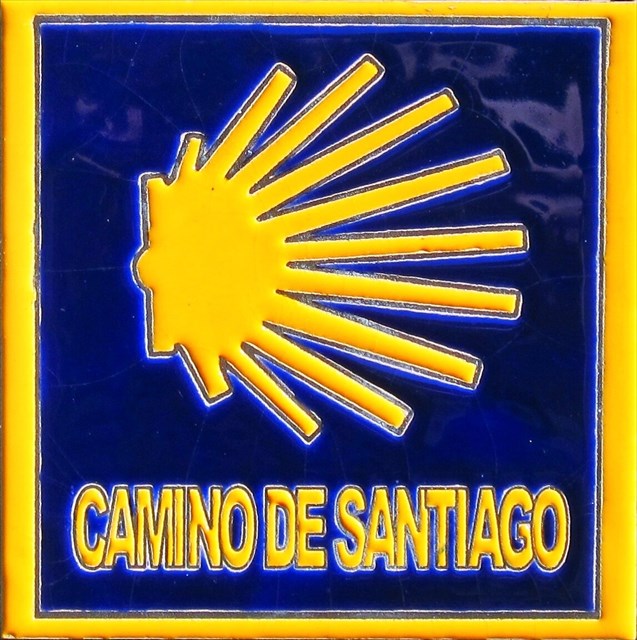 Vítejte u multikeše věnované poutní cestě do Santiaga de Compostela, známé též jako Svatojakubská cesta. Čeká Vás trasa dlouhá 2500 km, cestou navštívíte čtyři země, uvidíte devět katedrál napříč Evropou a nakonec dorazíte až na konec světa, odkud dál už je jen Atlantik.
Vítejte u multikeše věnované poutní cestě do Santiaga de Compostela, známé též jako Svatojakubská cesta. Čeká Vás trasa dlouhá 2500 km, cestou navštívíte čtyři země, uvidíte devět katedrál napříč Evropou a nakonec dorazíte až na konec světa, odkud dál už je jen Atlantik.
Welcome to a multi-cache dedicated to the pilgrimage route to Santiago de Compostela, also known by the name St. James‘s Way. You can expect to cover an overall distance of 2500 kilometres, to visit four countries on the way, to admire nine cathedrals across Europe and, finally, to arrive at the end of the world, where only the Atlantic Ocean is stretching any further.
Historie
Svatojakubská cesta je tradiční poutní cestou do Santiaga de Compostela, kde jsou v katedrále uloženy ostatky svatého Jakuba, Kristova učedníka a jednoho z dvanácti apoštolů. Ten byl původně pohřben v Jeruzalémě, ale v 8. století byly jeho ostatky převezeny třemi mnichy do Španělska na ochranu před Saracény, když strážci kláštera odpadli k islámu. Nejprve byla za místo zvolena Zaragoza, ta byla ale v roce 714 dobyta Maury. Na ochranu byly ostatky přeneseny k Irii Flavii v Galicii, kde na čas upadly v zapomnění a teprve roku 813 byly v tamní mramorové hrobce roku objeveny biskupem Teodomirem z Irie. Král Alfons Cudný dal nad hrobem vystavět ke cti sv. Jakuba roku 816 kapli, která byla posvěcena 25. července 816 - odtud je stanoven den svátku jména Jakub. Biskup k němu přeložil své sídlo a okolo začalo vyrůstat město Santiago de Compostela.
První doloženou pouť k hrobu sv. Jakuba vykonal roku 951 francouzský biskup z Le Puy. Další poutníci následovali, a tak postupně byly podél cest vztyčovány orientační kameny, kříže, boží muka a studánky. Později pak byly zakládány i kostely a kláštery poskytující poutníkům azyl. Vznikla radiální síť dvanácti tradičních cest z Francie, Itálie a Portugalska, připomínající svým tvarem mušli hřebenatky, která se stala jejím symbolem. Zájem o svatojakubskou cestu začal prudce stoupat koncem 20. století, k čemuž přispěla jednak pouť papeže Jana Pavla II., stejně tak jako zapsání svatojakubské cesty na seznam světového dědictví UNESCO a její nové vyznačení díky grantu Evropské unie. Zatímco v 70. letech cestu podnikalo ročně asi 100 poutníků, v současnosti ji z různých míst vykoná ročně přes 200.000 lidí.

History
The St. James’s Way represents a traditional pilgrimage route to Santiago de Compostela where the Saint James’s remains, one of the Jesus’s disciples and Twelve Apostles, are buried. Originally, he was buried in Jerusalem, but in 8th century his remains were transported to Spain by three monks as a protection against Saracens as the church keepers converted to Islam. The first place chosen was Zaragoza, but the city was conquered by the Moors in 714. To protect the remains, they were transported to Iria Flavia in Galicia where they fell into oblivion for some time and were rediscovered in the local marble tombstone by the bishop Teodomir from Iria as late as in 813. To honour St. James, the king Alfonso the Chaste ordered to build a chapel over the tombstone in 816 that was consecrated on 25th July 816 – that’s also the very day on which the name James is celebrated. The bishop transferred his residence to this place and the city of Santiago de Compostela started to develop all around.
The first pilgrimage to the St. James’s tombstone was done by the French bishop Le Puy in 951. Afterwards, other pilgrims followed, and stone markers, crosses, wayside shrines and natural springs were erected along the way. Later on, churches and monasteries granting asylum to pilgrims were founded. This way, a radial network of traditional routes from France, Italy and Portugal was created reminding a scallop by its form that became its symbol. There was a steep rise in interest in the St. James Way at the end of 20th century that was largely caused by the pilgrimage of the Pope John Paul II., as well as the introduction of the Saint James’s Way to the World heritage list of UNESCO and its new marking thanks to EU funding programmes. While there were approximately 100 pilgrims doing their pilgrimage in the 70ties, there are around 200 000 people doing it from various place all over the world today.
O keši
Praha je jedním z nejvzdálenějších míst, odkud se poutníci na tuto cestu vydávají. Jak svou pouť do Santiaga de Compostela absolvujete, zda pěšky, na kole, autem či balónem, je na každém z vás. V každém případě jde o ojedinělý zážitek, který si budete zřejmě pamatovat po zbytek života.
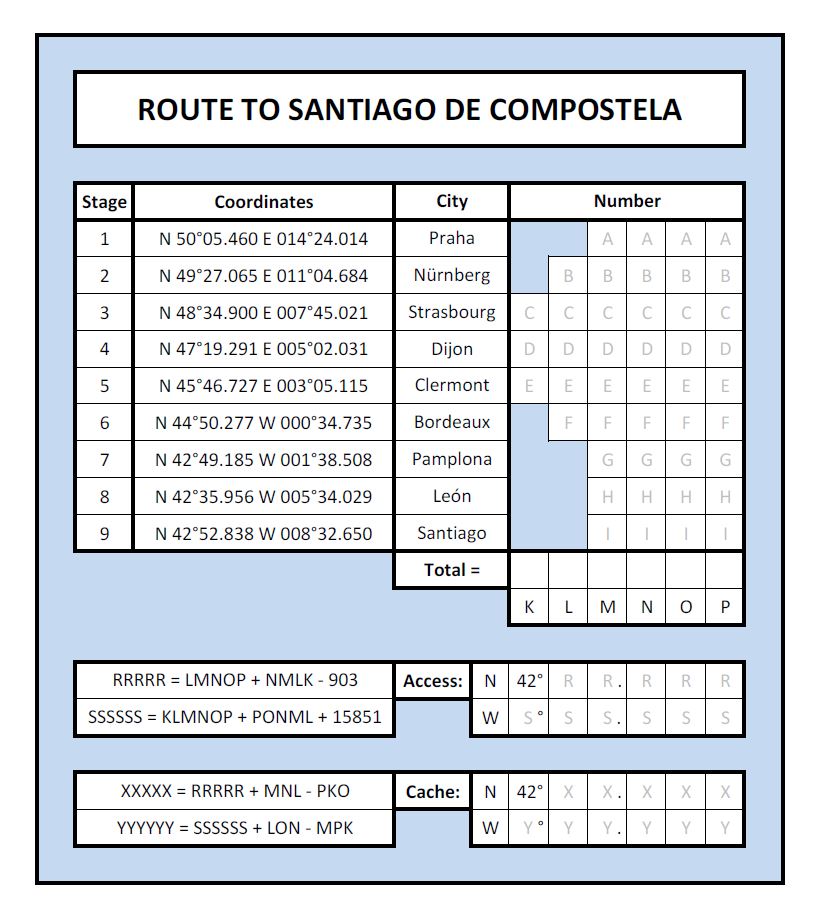 Cesta Vás přivede k devíti monumentálním katedrálám, trasa je tedy i srovnávacím průřezem stylů vrcholné sakrální výstavby Evropy. Zde máte k dispozici tabulku, do níž si na každé stagi budete zapisovat zjištěný číselný údaj. Pokud je v čísle desetinná čárka, tak ji ignorujte, např. 12,34 = 1234. Hledaný údaj je vždy z venku, přístupný 24 hodin. Návštěva interiérů katedrál tak není nutná, přesto nanejvýš doporučuji si je prohlédnout i zevnitř, když už tu budete. Poslední stage v Santiagu je výjimkou, zde je údaj uvnitř katedrály u stříbrné schránky s relikviemi sv. Jakuba a je tedy přístupný pouze přes den.
Cesta Vás přivede k devíti monumentálním katedrálám, trasa je tedy i srovnávacím průřezem stylů vrcholné sakrální výstavby Evropy. Zde máte k dispozici tabulku, do níž si na každé stagi budete zapisovat zjištěný číselný údaj. Pokud je v čísle desetinná čárka, tak ji ignorujte, např. 12,34 = 1234. Hledaný údaj je vždy z venku, přístupný 24 hodin. Návštěva interiérů katedrál tak není nutná, přesto nanejvýš doporučuji si je prohlédnout i zevnitř, když už tu budete. Poslední stage v Santiagu je výjimkou, zde je údaj uvnitř katedrály u stříbrné schránky s relikviemi sv. Jakuba a je tedy přístupný pouze přes den.
Část trasy z Dijonu do Pamplony má tři možné varianty, z nichž keš je vedena přes města s nejvýznamnějšími katedrálami. Pokud budete preferovat jižnější trasu přes Le Puy nebo severnější přes Limoges, napište mi a pošlu Vám hodnoty z minutých stagí.
About geocache
Prague is one of the most distant places where pilgrims set off on this way. It is all up to every one of you how you go to Santiago de Compostela, whether on foot, on bike, by car or by balloon. Anyway, it is a unique experience that you will probably remember for the rest of your life.
The route brings you to nine monumental cathedrals, which means that it also offers the possibility of comparing all existing styles of late European sacral architecture. There is a table in the geo-caching table you will use to enter numeral information on every stage. Should it contain a decimal comma, e.g. 12,34 = 1234, please ignore it. The information is always accessible from outside, 24 hours a day. You don’t necessarily need to visit the cathedral interiors, but, in spite of that, I highly recommend doing that when being here. The last stage situated in Santiago represents an exception as the information here is situated at the silver casket with St. James’s relic which means it is only accessible by day.
One part of the route from Dijon to Pamplona offers three options, where the caching route leads across cities with most significant cathedrals. Should you prefer taking the more southwards leading Le Puy route or more northwards leading one across Limoges, please contact me and I’ll send you values for the missed stages.
Limitovaná edice CWG
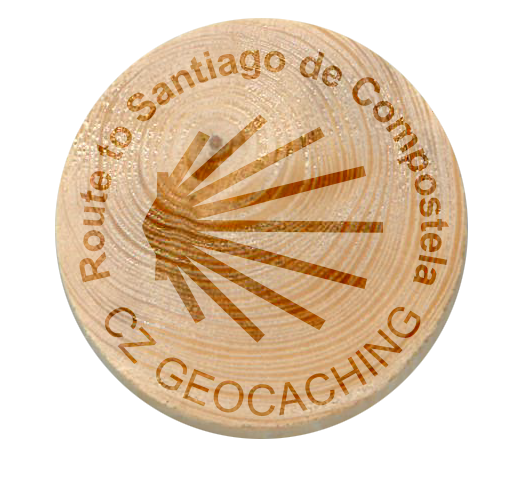 Pro prvních 100 návštěvníků je v keši připravené památeční CWG z limitované série, které nelze nikde jinde získat. Každý, kdo cestu absolvuje, si může bez výměny jako ocenění za vykonanou pouť jedno vzít. Berte si prosím čestně každý jen jedno (tedy ne pro kamarády na výměnu), ať zbyde i na ty po Vás, kteří cestu absolvují, děkuji. Navíc odměnou pro prvního, kdo tuto multikeš po publikaci absolvuje pěšky, je nový neaktivovaný Templářský geocoin. Není v keši, pro předání mě pak stačí kontaktovat.
Pro prvních 100 návštěvníků je v keši připravené památeční CWG z limitované série, které nelze nikde jinde získat. Každý, kdo cestu absolvuje, si může bez výměny jako ocenění za vykonanou pouť jedno vzít. Berte si prosím čestně každý jen jedno (tedy ne pro kamarády na výměnu), ať zbyde i na ty po Vás, kteří cestu absolvují, děkuji. Navíc odměnou pro prvního, kdo tuto multikeš po publikaci absolvuje pěšky, je nový neaktivovaný Templářský geocoin. Není v keši, pro předání mě pak stačí kontaktovat.
A nyní již vzhůru na cestu. Pěkně si ji užijte. ;-)
CWG limited edition
The first 100 visitors will find a keepsake CWG from the limited edition in the cache that is not available anywhere else. Every pilgrim who has done the pilgrimage can take one of these without swapping as a reward for having done the pilgrimage. Please be good and take only one piece of it (so not for friends for swapping), so that other pilgrims coming after you and doing the pilgrimage can take one of these as well. Moreover, the first visitor doing the multi-cache mission on foot upon its publication will be given a new deactivated Templar geocoin. Whereas it is not situated in the cache, please contact me for a handover then.
And now, please set off on your way. And enjoy it to the full. ;-)
Stage 1 – Praha – Katedrála sv. Víta
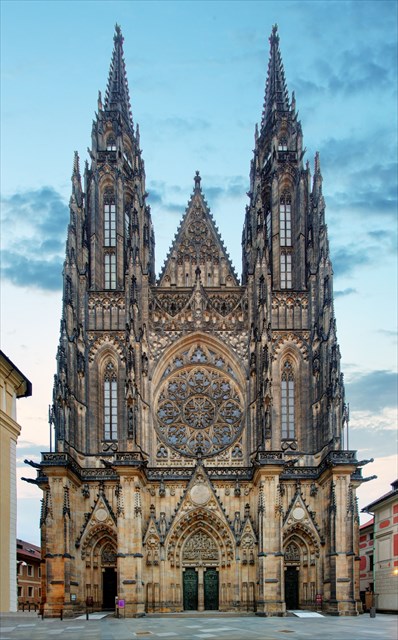 Gotická katedrála sv. Víta se stavěla díky přerušení husitskými válkami od roku 1344 až do roku 1929, kdy byla k 1000. výročí narození sv. Václava dokončena. Je místem posledního odpočinku nejvýznamnějších českých králů a také domovem českých korunovačních klenotů. Roku 1212 byl tehdy ještě bazilice sv. Víta darován zub a další dvě části z ostatků sv. Jakuba.
Gotická katedrála sv. Víta se stavěla díky přerušení husitskými válkami od roku 1344 až do roku 1929, kdy byla k 1000. výročí narození sv. Václava dokončena. Je místem posledního odpočinku nejvýznamnějších českých králů a také domovem českých korunovačních klenotů. Roku 1212 byl tehdy ještě bazilice sv. Víta darován zub a další dvě části z ostatků sv. Jakuba.
Na severní straně katedrály je ve výši očí do kamene vytesaný letopočet AAAA.
Due to the Hussite wars, the Gothic St. Vitus cathedral was constructed from 1344 to 1929, when it was finally completed to commemorate the 1000th birth anniversary of St. Wenceslas. It is the final resting place of the most significant Czech kings and a place where Czech crowning jewels are located. In 1212, yet the St. Vitus basilica was granted a tooth and two more parts of St. James’s remains.
On the northern facade of the cathedral, there is a date AAAA engraved in the stone at eye level.
Stage 2 – Nürnberg – St. Lorenz
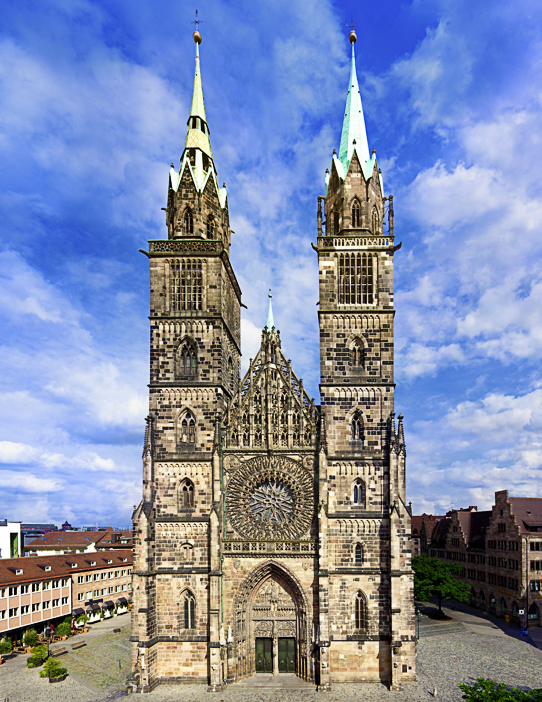 Norimberská katedrála sv. Vavřince byla postavena v letech 1250 – 1477. Její stavbu a výzdobu financovali hlavně bohatí měšťané. Z tohoto důvodu také jako jedna z mála bez úhony přežila protestantský ikononklasmus okolo roku 1530, kdy byly v mnoha evropských chrámech ničeny církevní ikony. Měšťané ale trvali na zachování kulturního odkazu svých předků, a tak byl kostel nedotčen.
Norimberská katedrála sv. Vavřince byla postavena v letech 1250 – 1477. Její stavbu a výzdobu financovali hlavně bohatí měšťané. Z tohoto důvodu také jako jedna z mála bez úhony přežila protestantský ikononklasmus okolo roku 1530, kdy byly v mnoha evropských chrámech ničeny církevní ikony. Měšťané ale trvali na zachování kulturního odkazu svých předků, a tak byl kostel nedotčen.
Nalevo od vstupu je na stěně železný etalon míry s dvěma údaji v cm. Sečtěte je a získáte BBB,BB cm.
The St. Lorenz church was built in 1250 – 1477. The construction and the decoration were largely funded by wealthy townsmen. Due to this fact, it was also one of the few monuments that survived the protestant iconoclasm around 1530 without any damages where a lot of church icons were destroyed in many European cathedrals. However, the townsmen insisted on preserving the cultural heritage of their ancestors, so, the church has remained intact.
To the left of the entrance, there is a metal etalon containing two measurements in centimeters. By adding them up you will get BBB,BB centimeters.
Stage 3 – Strasbourg – Cathedrále Notre Dame
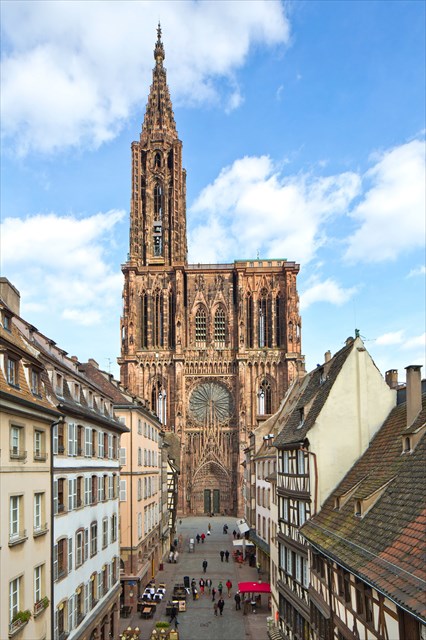 Vrcholně gotická katedrála Notre Dame z let 1176 – 1439 je jedním z architektonických vrcholů této cesty. Je charakteristická svou jedinou věží vysokou 142 metrů, díky které byla v letech 1647 – 1874 nejvyšší stavbou světa. Druhá věž nebyla nikdy postavena především z ekonomických důvodů, ale také z obav, zda by ji základy unesly. Za povšimnutí stojí bohatá zdobnost průčelí s nádhernou rozetou.
Vrcholně gotická katedrála Notre Dame z let 1176 – 1439 je jedním z architektonických vrcholů této cesty. Je charakteristická svou jedinou věží vysokou 142 metrů, díky které byla v letech 1647 – 1874 nejvyšší stavbou světa. Druhá věž nebyla nikdy postavena především z ekonomických důvodů, ale také z obav, zda by ji základy unesly. Za povšimnutí stojí bohatá zdobnost průčelí s nádhernou rozetou.
Vlevo od prostředních vstupních dveří je železná nivelační značka s údajem CCC,CCC m.
The finest masterpiece of Gothic architecture, Notre-Dame de Strasbourg, built in 1176 – 1439, represents one of the top architectural objects on the route. It is characteristic of its 142 metre high tower that made it the highest building in the world in 1647 – 1874. The second tower has never been built, mostly due to economic reasons, but also because of fears whether its foundations were strong enough to withstand its pressure. Very noticeable are multiple ornaments on the front facade with the beautiful rosette.
To the left of the middle entrance door, there is a metal level marker showing CCC,CCC m.
Stage 4 – Dijon - Cathédrale Saint-Bénigne
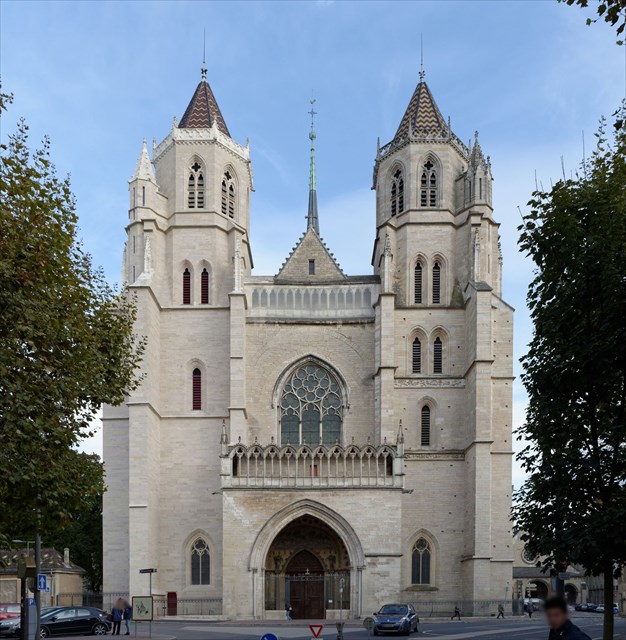 Raně gotická katedrála z let 1280 – 1325 vyrostla na základech původní románské baziliky po tom, co se roku 1272 zřítila hlavní věž nad její vnitřní rotundou. Průčelní věže jsou tedy v románském stylu, zatímco dostavba nad rotundou i s nejvyšší věží je už gotická. Díky svému bazilikálnímu uspořádání stojí v interiéru za povšimnutí kontinuální ochoz nad celou hlavní lodí, což v klasické gotice už není obvyklé. Vpravo od vchodu je další železná nivelační značka s údajem DDD,DDD m.
Raně gotická katedrála z let 1280 – 1325 vyrostla na základech původní románské baziliky po tom, co se roku 1272 zřítila hlavní věž nad její vnitřní rotundou. Průčelní věže jsou tedy v románském stylu, zatímco dostavba nad rotundou i s nejvyšší věží je už gotická. Díky svému bazilikálnímu uspořádání stojí v interiéru za povšimnutí kontinuální ochoz nad celou hlavní lodí, což v klasické gotice už není obvyklé. Vpravo od vchodu je další železná nivelační značka s údajem DDD,DDD m.
The early Gothic cathedral from 1280 – 1325 is based on the foundations of the original Romance basilica after the main tower over its inner rotunda crashed down in 1272. The front towers were made in Romanesque style while the annex over the rotunda along with the highest tower was made in Gothic style. Thanks to its basilica layout, the continuous gallery over the entire nave is very noticeable, which is not quite usual in the classical Gothic architecture.
To the right of the entrance, there is another metal level marker showing DDD,DDD m.
Stage 5 – Clermont-Ferrand – Cathédrale Notre-Dame-de-l'Assomption
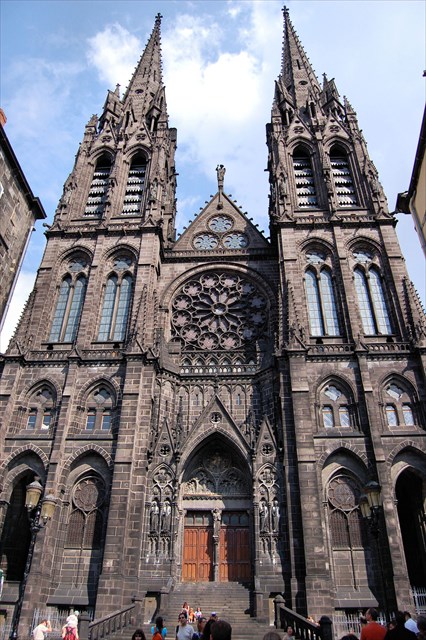 Podobně jako u sv. Víta, i dokončení katedrály v Clermontu trvalo několik staletí, konkrétně 1248 – 1884. Katedrála je postavena z tmavého lávového kamene, který je typický pro okolí města, kde se nalézá přes 80 sopek. Vzhledem k nízké okolní zástavbě je katedrála nepřehlédnutelnou dominantou města. Po zjištění indicie doporučuji jít se podívat dozadu za katedrálu, je zde na domech unikátní perspektivní malba.
Podobně jako u sv. Víta, i dokončení katedrály v Clermontu trvalo několik staletí, konkrétně 1248 – 1884. Katedrála je postavena z tmavého lávového kamene, který je typický pro okolí města, kde se nalézá přes 80 sopek. Vzhledem k nízké okolní zástavbě je katedrála nepřehlédnutelnou dominantou města. Po zjištění indicie doporučuji jít se podívat dozadu za katedrálu, je zde na domech unikátní perspektivní malba.
Vlevo od vstupu najdete opět známou nivelační značku s údajem EEE,EEE m.
Similarly to the St. Vitus cathedral, it took several centuries to complete the construction of the Clermont cathedral, more precisely, from 1248 – 1884. The cathedral was built of dark lava stone which is typical of the city surroundings where 80 volcanoes are situated. Compared to the low surrounding buildings, the cathedral represents an absolute eye-catcher of the city. After finding your value, it is highly recommended that you go behind the back side of the cathedral where there is a unique perspective painting on the houses.
To the left of the entrance, again, you’ll find the familiar level marker showing EEE,EEE m.
Stage 6 – Bordeaux – Cathédrale Saint-André
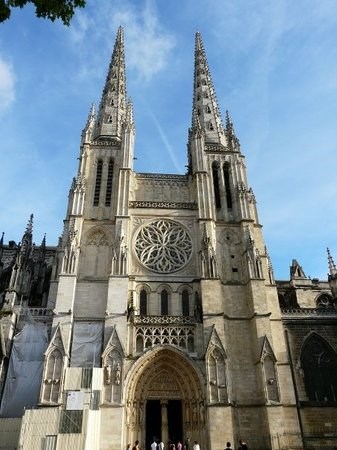 V Bordeaux se spojuje několik cest do Santiaga a zdejší katedrála je tak už brána jako skutečné poutní místo. Katedrála je zajímavá tím, že východní část z 12. – 15. století je gotická, zatímco západní polovinu tvoří původní románský kostel dokončený roku 1096. Velmi výrazně je toto slohové spojení vidět v interiéru, kdy je každá polovina katedrály zcela odlišná.
V Bordeaux se spojuje několik cest do Santiaga a zdejší katedrála je tak už brána jako skutečné poutní místo. Katedrála je zajímavá tím, že východní část z 12. – 15. století je gotická, zatímco západní polovinu tvoří původní románský kostel dokončený roku 1096. Velmi výrazně je toto slohové spojení vidět v interiéru, kdy je každá polovina katedrály zcela odlišná.
U blízkého paláce Rohan najdete naposled známou nivelační značku s údajem FF,FFF m.
In Bordeaux, several routes to Santiago come together and, thus, the local cathedral is already considered a real pilgrimage place. The cathedral is particularly noteworthy because of the fact that the eastern side dating back to 12th – 15th century was built in Gothic style while the western half is represented by a Romance church finished in 1096. The combination of the aforementioned architectural styles is largely evident from the interior where each of the parts is completely different.
At the nearby Rohan palace there is the last known level marker showing FF,FFF m.
Stage 7 – Pamplona – Catedral de Pamplona
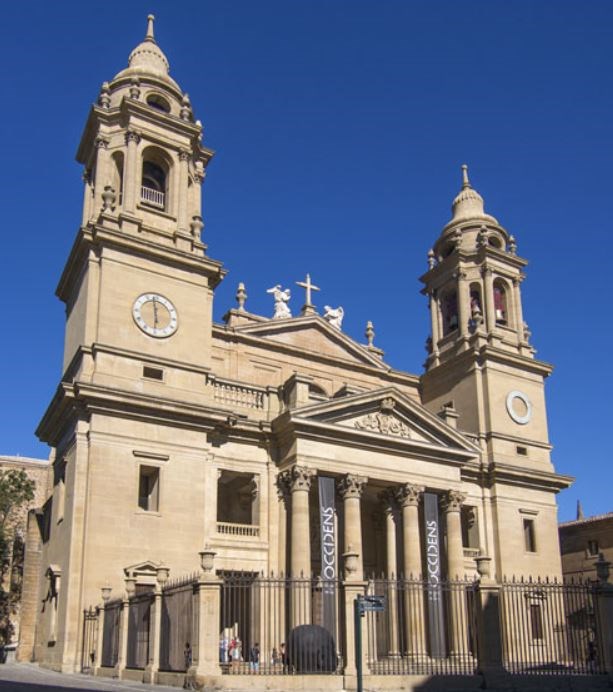 V Pamploně se všechny trasy spojují do hlavní páteřní cesty, symboly pouti do Santiaga jsou tu už všudypřítomné. Zdejší původní románský kostel se zřítil roku 1391, zůstala tehdy stát pouze čelní fasáda. Na jeho místě vyrostla tedy v letech 1394-1501 nynější pozdně gotická katedrála. Původní románskou fasádu nakonec nahradila roku 1783 současná neoklasicistní fasáda, velmi odlišná od ostatních katedrál.
V Pamploně se všechny trasy spojují do hlavní páteřní cesty, symboly pouti do Santiaga jsou tu už všudypřítomné. Zdejší původní románský kostel se zřítil roku 1391, zůstala tehdy stát pouze čelní fasáda. Na jeho místě vyrostla tedy v letech 1394-1501 nynější pozdně gotická katedrála. Původní románskou fasádu nakonec nahradila roku 1783 současná neoklasicistní fasáda, velmi odlišná od ostatních katedrál.
Na stěně domu najdete zelenou kovovou tabulku, na níž jsou čtyři letopočty. Jejich součet Vám dá GGGG.
In Pamplona, all routes come together to create the main route, and symbols of the pilgrimage route to Santiago are to be found in all places there. The original local Romance church crashed down in 1391, but the only remaining part, the front facade, was preserved. In its place, the contemporary late Gothic cathedral was built in 1394-1501. The original Romance facade was eventually replaced by the contemporary neoclassical facade in 1783 which is very different from other cathedrals.
There is a green metal table to be found on the wall with four years on it. The total shall make GGGG.
Stage 8 – León – Catedral de León
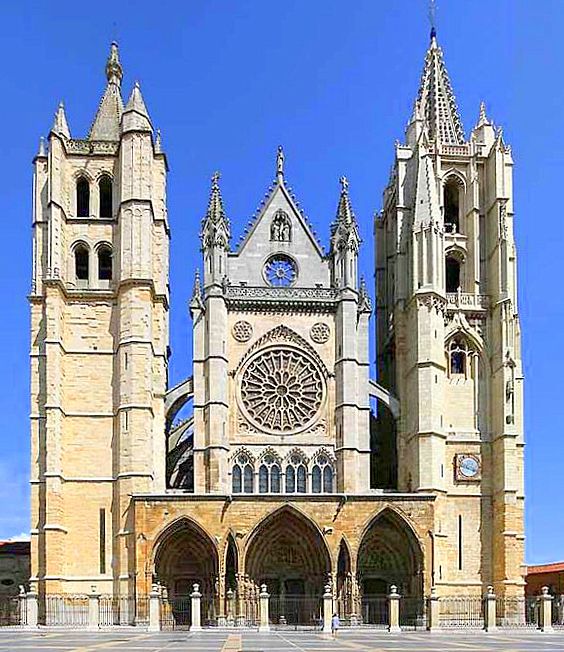 Jste na poslední zastávce před Santiagem. Katedrála v Leónu je vybudována na místě starověkých římských lázní. Jejich vykopávky si také můžete prohlédnout pod přilehlým náměstím. Gotická katedrála je už v pořadí třetí sakrální stavbou na tomto místě. Stavěla se přes dvě stě let a dokončena byla v polovině 15. století. Zajímavá je svou světlou barvou použitého konstrukčního kamene.
Jste na poslední zastávce před Santiagem. Katedrála v Leónu je vybudována na místě starověkých římských lázní. Jejich vykopávky si také můžete prohlédnout pod přilehlým náměstím. Gotická katedrála je už v pořadí třetí sakrální stavbou na tomto místě. Stavěla se přes dvě stě let a dokončena byla v polovině 15. století. Zajímavá je svou světlou barvou použitého konstrukčního kamene.
Napravo od hlavního vchodu naleznete nivelační tabuli s výškou HHH,H m.
The last stop to Santiago. The cathedral in León was built on the foundations of the ancient Roman spa. The excavations can also be seen beneath the adjacent square. The Gothic cathedral is the third sacral building at this place in row. It was built for more than two centuries and completed in the middle of 15th century. It is interesting due to light color used on the construction stones.
To the right of the main entrance, there is a level table showing the altitude of HHH,H m.
Stage 9 – Santiago de Compostela – Catedral de Santiago de Compostela
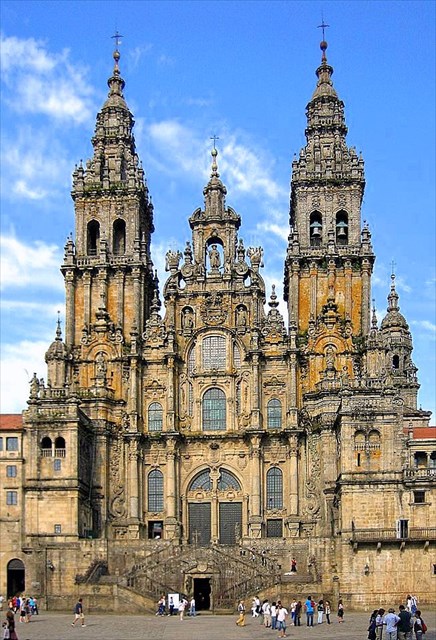 Dorazili jste do cíle cesty. Na místě hrobu sv. Jakuba byla roku 829 postavena kaple, později kostel, později větší kostel, až v letech 1075 – 1211 byla vystavěna současná románská katedrála, která je tak nejstarší z katedrál, které jste cestou navštívili. Jedná se o monumentální katedrálu s půdorysem kříže, v jehož středu je centrální oltář, ve třech lodích je systém lavic pro věřící a ve čtvrté horní části kříže jsou uloženy relikvie sv. Jakuba.
Dorazili jste do cíle cesty. Na místě hrobu sv. Jakuba byla roku 829 postavena kaple, později kostel, později větší kostel, až v letech 1075 – 1211 byla vystavěna současná románská katedrála, která je tak nejstarší z katedrál, které jste cestou navštívili. Jedná se o monumentální katedrálu s půdorysem kříže, v jehož středu je centrální oltář, ve třech lodích je systém lavic pro věřící a ve čtvrté horní části kříže jsou uloženy relikvie sv. Jakuba.
Poslední indicii naleznete uvnitř katedrály, v podzemním prostoru, kde je vystavena stříbrná schránka s ostatky sv. Jakuba. Při pohledu na ni máte za zády tabuli, na níž je mimo jiné letopočet IIII.
You have arrived at your destination. At the place of St. James’s tombstone, a chapel was built in 829, later on a church, even later a larger church, but only as late as in 1075 – 1211, the contemporary Romance cathedral was built there, making it the oldest cathedral of all you could see on your way over here. It is a monumental cathedral with cross ground plan and the central altar in the middle of it, the three naves house a system of benches for the faithful and the fourth upper part of the cross ground plan shelters the St. James’s remains.
The last clue is in the underground area inside the cathedral where the silver casket of the St. James’s remains is exhibited. When looking at it, a table shall be situated behind your back including a year IIII.
Cache
Ke keši je to ze Santiaga už jen kousek. Pokud jste si do tabulky správně vyplnili všechny hodnoty, stačí je všechny sečíst a spočítání souřadnic by pak už neměl být problém. Keš je umístěna na pěkném, ale velmi nedostupném místě, ke kterému jediný rozumný přístup vede přes bod „Access“. Při vytahování keše z úkrytu ji prosím napřed trochu nadzvedněte, ať ji nevyndáte i s jejím podložím, stejně tak ji pak prosím vraťte tak, aby v úkrytu stabilně držela, děkuji.
To je vše, jste na konci tohoto dobrodružství. A užijte si výhled od keše, koneckonců je to jediná česká keš s výhledem na oceán. :-)
From Santiago, you are quite close to the cache. Should you have filled in all values in the table correctly, add them up and it shall be quite easy to calculate the coordinates. The cache is situated in a nice, but a very hard-to-reach place with only one reasonably accessible spot through „Access“. Please lift the cache a bit before pulling it out of its place so as not to pull it out along with the ground, then, please put it back in such a way that it will stay fixed at the place.
And that’s it, the adventure is over now. Enjoy the vista from the cache, it is the only Czech cache with a view of the ocean anyway :-)

